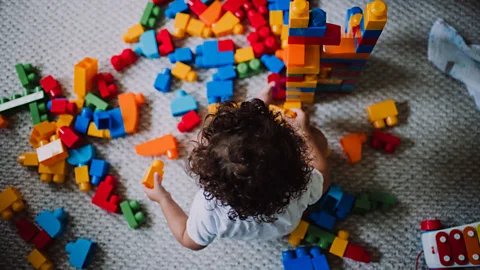The parents raising their children without gender
 Courtesy of Markus Tschannen
Courtesy of Markus TschannenSome parents are championing ‘gender-creative’ parenting styles, which are designed to let children pick their own identities later in life.
As 2022 comes to a close, we're bringing back our favourite pieces of the year. See the rest of our Best of Worklife 2022 collection for more great reads.
As Gabriella Martenson prepared for the birth of her first child, she came to a decision. She wouldn’t tell her child if they’d been born a girl or a boy, and would largely avoid discussing their birth sex with people outside her family and friendship group.
“I wanted them to be who they want to be. I don't want to decide that for them,” says Martenson, who was 30 and living in her home city, Stockholm, when she had her first child. “[It’s] just as I don't want to decide what they grow up to do, or who they decide to love or live with.”
As a child herself, Martenson had mostly been raised within stereotypical gender norms, such as being given pink belongings and dresses to wear. But in her late teens, she says she “discovered feminism” and began questioning gender norms. So, when she became a mother, she chose to buy her own child a wide range of clothes and gifts, ranging from trains to dolls, giving them free choice as to which they wanted to use on any given day.
She hoped her parenting style would help her child feel more comfortable exploring a range of hobbies and studies, rather than nudging them towards more gender-stereotypical activities. She also believed raising a child without gender would make things easier if they eventually identified as a gender different from their assigned birth sex, and help them accept other people who don’t adhere to the gender binary or other societal norms. “I'm letting them be anything… and teaching them to not be so narrow minded,” she says.
Martenson, who’s since repeated the approach with her two other children, is part of what some experts say is a small yet growing number of parents – both straight and queer – who’ve opted for gender-neutral parenting in recent years. It’s unclear exactly how many families have adopted this strategy, since there’s been little academic or public research into the micro-trend. But parenting authors, psychotherapists and preschool teachers alike anecdotally say they’ve noticed the practice ticking up in the past decade, particularly in northern Europe and the US.
While more parents are opting for this approach – however niche the trend may still be – it's an unconventional choice, and not one without pushback, even controversy. Yet parents who buck entrenched child-rearing practises have specific motivations for doing so as well as practical approaches they take. Understanding these can help others make sense of their choices, and even shed light on what an untraditional parenting approach might mean for the future of raising a child.
 Courtesy of Gabriella Martenson
Courtesy of Gabriella MartensonThe rise of gender-neutral parenting
Berlin-based queer gender-neutral parenting author, blogger and lecturer Ravna Marin Nathanael Siever says choosing not to label a young child as a boy or girl started to gain traction in the 1980s, mostly in queer communities. This coincided with what they describe as “the second wave of feminism”, with women rebelling against being typecast as caregivers in the home or in certain jobs.
Siever’s research for their book involved reviewing decades of existing gender studies literature as well as speaking to parents themself. They say many of the people attracted to gender-neutral parenting want to avoid subjecting their kids to experiences they had themselves; growing up in a world where male-female stereotypes and power structures were more prevalent than they are today, transgender people faced higher levels of discrimination and LGBTQ+ relationships were less accepted, all of which impacted on people who didn’t conform to these norms. Gender-neutral parenting, therefore, emerged not to “neutralise” children’s genders, “but to allow them to discover their own identity, rather than being told about it by others”, says Siever, who uses they/them pronouns.
Some English-speaking parents prefer the term “gender-creative parenting” to help avoid confusion that the goal is to “neutralise” gender, says Siever; some also use the term “gender-open parenting” for similar reasons.
However it is defined, this kind of parenting mostly remained niche into the 90s and 2000s, says Siever, but became slightly more well known in the early 2010s, after a number of queer and straight families shared their stories in the media, generating high-profile, polarised debates. These included a Toronto-based couple who raised a child called Storm without giving them a gender label, and a cis husband and his genderqueer wife in Salt Lake City, who documented their journey bringing up a kid called Zoomer on social-media channels. Meanwhile, global reports about some preschools in Sweden avoiding using the words for ‘him’ and ‘her’ for all attending pupils also helped put gender-neutral ideologies in the spotlight, says Siever.
Around this same period, Siever – who identifies as transgender, non-binary and polyamorous – began raising the first of three children without gender labels. Siever explains that their personal experiences growing up in the 1990s heavily impacted their decision. Although their parents were influenced by earlier feminist waves that encouraged children to “do whatever” they wanted in of activities, they still labelled Siever a girl, which they didn’t feel comfortable with. “It took me until my late 20s to figure out I could just step out of that box, because I had no words for it. I wasn't told the language for it,” says Siever.
Like Martinson, Siever believes gender-neutral parenting from birth makes life easier for kids who decide they don’t fit into binary norms, and could help these children avoid some of the “confusion” Siever experienced during their own youth. They also hope that the approach will help spread feminist messages more broadly. “Rigid ideas of gender have been discussed as the main source of patriarchal oppression by decades of feminist work,” says Siever, who reviewed decades of gender studies literature for their book. “The more open our kids can grow up, the less gendered power structures will influence who has power in society and thus who profits most from it.”
Mark Vahrmeyer, a psychotherapist who works with families in Brighton, England, adds that in the 2020s, conversations about gender identity and gendered oppression have become much more commonplace in media and society, and that this is helping to show parents that there are alternative ways to raise a child.
“More parents are aware of the possibility of raising a gender-neutral child,” he says, due to the increasing use of they/them pronouns as well as a general growing awareness of the impact of stereotypes and biases. From his experiences working with both parents and teenagers, he says “increasing numbers of parents wish to give their child the space psychologically and emotionally to fully express who they are by minimising the conscious and unconscious impact that gender bias can have on a child – for example, seeing girls as ‘weaker’ or boys as ‘smarter’.”
 Courtesy of Markus Tschannen
Courtesy of Markus Tschannen‘They can experience what feels best for them’
The actual practise of gender-neutral parenting differs – and the approaches parents take are often personal in nature, related to their own societal perceptions and experiences.
Among families, one option in English-speaking countries is for parents to refer to their offspring using they/them pronouns. The word ‘theyby’ – a blend of the words ‘they’ and baby’ – has emerged to describe these children. Some parents prefer to use a mixture of ‘he’ and ‘she’ pronouns instead. Others, like Martinson, don’t use the words ‘boy’ or ‘girl’, but do feel comfortable using their child’s birth sex pronoun (unless the child requests otherwise), while prioritising neutral alternatives such as ‘child’, ‘friend’ or ‘sibling’.
Markus Tschannen, a part-time writer, who is embracing a gender-neutral parenting approach from a German-speaking area of Switzerland, says he would like to identify his children with a gender-neutral pronoun such as ‘they’, however this currently doesn’t exist in the German language.
Family Tree
This story is part of BBC's Family Tree series, which examines the issues and opportunities parents, children and families face today – and how they'll shape the world tomorrow. Find more on BBC Future.
Instead, he and his wife call their two young children by different nicknames that don’t always conform to gender stereotypes. In German, all nouns have a masculine, feminine or so-called ‘neuter’ prefix. The word ‘mouse’, for example, is a feminine noun with the gendered prefix ‘die’ (die Maus). Tschannen says most German parents would therefore avoid giving this animal nickname to a boy, however his family wouldn’t think this way. “Being gender-creative parents, we deliberately use names with all three grammatical genders,” he says. “This comes with the advantage that they can experience what feels best for them before deciding on a preferred pronoun,” he explains. “We basically wanted to give them more options than a society that tries to put children in a gender-based mould early on.”
He and his wife are straight, and each identify as their birth gender. For them, gender-neutral parenting was less a reaction to their own childhoods, and more a case of looking at the evolving world and deciding to do things differently. In particular, they say they were both appalled by the “heavy marketing” of gendered books, clothes and toys which, Tschannen believes, has “exploded” in Switzerland over the last few decades.
The couple, like Martinson, buy their kids clothes “from both sides of the aisle”, and try to expose them to a broad selection of belongings and entertainment. “We make sure that they read books or watch films that represent a certain diversity, and don’t reproduce too many gender stereotypes,” he says. “But most importantly, we watch our language so as to not reproduce gender stereotypes ourselves, and we try to be good role models. Also, we openly talked about gender and sexuality early on – in an age-appropriate way, of course.
Like Martinson and Siever, Tschannen also hopes the experience will make for a less bumpy ride if his kids identify as LGBTQ+, and encourage them to accept others who fit into these categories. “It's realistic that our children will meet other children that don't identify with their given gender at birth and that they will meet a lot of queer people in their life,” he says. “And I want our children to understand different gender identities and I want them to understand different pronouns.”
He accepts that other parents may feel they can encourage these values without changing their language and behaviours to such an extent, and believes parents can find the place on the “gender-neutral spectrum” where they feel most comfortable. Nevertheless, in his opinion, he believes his family’s approach is potentially more “helpful” in fighting to dilute gender stereotypes and stigmas.
Unknown impacts
Since gender-neutral parenting remains a relatively recent and limited phenomenon, researchers don't yet know much about its long-term impact, including how it is affecting both children and wider society.
Proponents of the approach argue it is making a mark, at least on an individual level.
Based on his experience, Tschannen says that in his area of Switzerland, there’s still a lot of “talk about things ‘just being for boys’ or ‘for girls’ respectively”. However, he says his children don’t “buy into this”. For instance, if his oldest kid hears a teacher casually saying that “boys don’t paint their nails”, they will “actively disagree or just silently shake their head”. He says this child – who shared their identity with their parents when they were around five, but doesn’t want it published – also tends not to “lean into ‘typically’ boys or girls’ interests”, colours or toys (though Tschannen says he would have no problem with it if they did).
Martinson’s oldest child, who is now 11, has identified as girl since she was around four, mirroring her birth sex. But Martinson is of the opinion that her daughter’s experiences growing up in a gender-neutral household have helped her to feel more comfortable pursuing a wide range of hobbies and embracing a gender-diverse wardrobe as she’s grown older. She says her daughter is already “very accepting” of peers who’ve come out as gay or “don’t dress like the norm”. Martinson says, “She doesn’t care about that. She thinks it’s cool and she thinks they’re brave to express this.”
 Getty Images
Getty ImagesBoth Tschannen and Martinson are clear that gender-neutral parenting doesn’t stop once a child chooses a gender they identify with. For instance, they still try to avoid gender-stereotyping language within the home. “When I talk about other kids, if it’s someone we know [well], I might say ‘she’ or ‘her’. But if it's a child at a playground or, you know, their friends at school, I just call them ‘your friends’ or by their names” rather than referring to “boys” and “girls”, says Martinson.
“As soon as the children can tell us what pronouns to use, we use them… but we still go along with kind of a gender-open, gender-creative or gender-neutral approach by using a rather diverse language because there is no reason for that to go away,” agrees Tschannen. “We still want the children to know what [range of] gender identities there are, and what options they have.”
But psychotherapist Vahrmeyer says his experiences working with clients suggest that not all kids exposed to this style of parenting will react positively. “For children who feel secure to explore the space their parents offer them, the journey can be one of discovery. However, for some children, the lack of prescribed identity can bring with it uncertainty and increased anxiety,” he says. Rather than rejecting gender norms as their parents had hoped, they may “find the lack of structure and guidance challenging”, and could even “revert to more strongly embedded gender identities to compensate for these feelings of uncertainty, and to grasp hold of some certainty”.
Mandee Lal, a certified children’s grief and mental health coach based in Wokingham, near London, champions some aspects of gender-neutral parenting, such as choosing a diverse range of clothes and toys. But she agrees that rejecting gendered pronouns may be confusing for some children, especially when most of their peers will still be categorised as girls or boys. “Saying that, you know, you're a ‘they’ – I don't think a child can understand what a ‘they’ is and perhaps [the child will] maybe feel like they don't then fit into the world.”
One of Lal’s children is transgender, and experienced “horrific bullying” at school. She believes children labelled ‘they’ may not escape a similar level of ridicule, even if their parents have taken this approach to avoid future tensions if their children don’t conform to gender norms. Meanwhile she points out that non-gendered kids may still need to manage a public “switch” in identity if they opt for a binary gender label later on. “If the parents choose ‘they’, then the likelihood of the child choosing their own gender as ‘he’ or ‘she’ is still pretty high. So, there's still a lot for that kid to go through. It's not necessarily shielding them.”
Parents who decide to raise their children without gender also need to be aware that even if they’re trying to promote freedom, their approach may not be without bias, adds Vahrmeyer. “A parent’s job is to be curious about who a child is and to listen to the child, rather than to impose a ‘project’ or ideology on their child. Thus, in the same way it is now appropriately viewed as toxic to tell a child how to be a girl or a boy, it can be equally damaging for a parent to impose any anti-gender-conforming views onto a child,” he says.
Erika Ohlsson, a behavioural scientist from Stockholm, is also of the opinion that some parents who adopt gender-neutral parenting are taking a political standpoint, for instance to “make a statement against the patriarchy”, or to justify problems in their own lives connected to how they’ve personally experienced gender. “I think it's about the parents themselves. I think they might not be happy and content with their own masculinity or femininity,” she argues. “Now they are given an opportunity, because of these ideological dogmas that are out there in the debates and in politics, which claim that you can choose your own [gender] reality.”
Common challenges
Given the conversation about the ethics and efficacy of gender-neutral parenting, experts agree that a common challenge for those who adopt the approach is learning how to handle external reactions.
“Gender-neutral parenting is still only done by relatively few people, and they still receive almost as much pushback as in the early 2010s,” argues parenting author Siever. They believe “people on the outside are still most likely going to sort every child into the ‘boy’ or the ‘girl’ box on every occasion, because the idea to treat people differently based on gender is just so fundamentally baked into our society”.
Vahrmeyer also warns “criticism may not only come from outside the family but from within, especially in the case of older generations such as grandparents”. This, he believes, could leave parents feeling anxious and alienated, especially if they don’t have a strong network.
 Getty Images
Getty ImagesIndeed, Martinson says her mother has continually questioned her parenting style, describing it as “strange” or “weird” that her children break gendered clothing norms, and says she has struggled to understand that Martinson won’t talk about her children’s gender identities until they do.
By contrast, Tschannen says his parenting style hasn’t been “as much of an issue” as he expected, and he’s yet to witness any severely negative reactions in person. “We explained it to friends and family without making too much of a fuss and they just [went] with it,” he explains. Nevertheless, he has experienced an online backlash from strangers whenever he’s written about his family. “Some think it’s extreme, they imply that we brainwash our children and take something (i.e. all aspects of gender) away from them,” he says. “People have a lot of misconceptions.”
A wider trend?
Whether gender-neutral parenting will become more accepted and more commonplace is an ongoing debate among followers and observers of the phenomenon.
Siever argues that recent examples of gender-neutral parenting in the news and on social media may be contributing to “a small rise in acceptance”. However, in their opinion, it won’t become a mainstream trend anytime soon. “I hope it will become much more common, but at the current pace this is going to take decades, especially with right-wing politics and talking points about protecting children from so-called ‘gender ideology’ on the rise everywhere in the Western world.”
Tschannen also believes there’s “a long way to go” before gender-neutral parenting stops being niche, despite the rising media attention to the phenomenon. He believes there’s a big difference between the noticeable increase in interest and tangible shifts in behaviour. “There’s a common reaction from generally open-minded parents who call it ‘an interesting idea’, but assume gender-neutral parenting to be hard to put into action and therefore don’t think about it much further.”
However, others, like Martinson, are more optimistic about the trajectory, especially in more progressive countries like Sweden, which has a history of championing gender equality and LGBTQ+ rights. In the years since she had her first child, Martinson says far fewer parents now stop her in the playground to ask about her children’s genders. Meanwhile she’s noticed much more gender fluidity in the marketing of children’s clothes and toys – “boys in pink, boys in tights and things like that” – which she thinks is having an impact on attitudes.
“I think [gender-neutral parenting] will be easier and more popular,” she argues. “In my mother’s generation most people don’t get it at all, but in my generation a lot of people do, so when my children have children, I think and I hope that gender won’t be an issue in the same way as it is now.”
Updated 3 October: This version does not include a line that may have been insensitive to readers.
